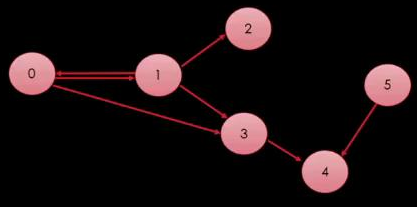주의사항
- "발견"이라는 개념
DFS는 방문의 개념을 이용했다
BFS는 발견의 개념을 이용한다
- 발견 큐
DFS의 핵심은 큐를 이용하는 것이다
발견한 정점들을 큐에 넣어주는 방식을 사용한다
- 발견 큐의 구조
일단 큐가 비어있기 때문에
시작 정점을 강제로 큐에 넣어주고 발견 여부를 true로 해주고 시작한다
이제 큐가 빌 때까지 큐를 실행하면 된다
큐에 들어있는 본인이 pop 되면서, 발견한 애들을 큐에 넣으면 된다
그리고 방문은 본인이 pop 되는 적절한 시점에 넣어주면 된다
- parent와 distance
본인을 발견한 parent를 저장하고 싶은 경우에는
큐에 push를 해주면서 발견여부를 true로 해줄 때
해당 큐를 발견한 정점을 넣어주면 된다
- distance
BFS 시작 지점으로부터 거리를 알고 싶은 경우에는
큐에 push를 해주면서 발견여부를 true로 해줄 때
해당 큐를 발견한 정점(부모)의 거리 + 1을 넣어주면 된다
BFS 구현
- 준비물
vector<Vertex> vertices;
vector<vector<int>> adjacent;
vector<bool> discovered;
1) 인접리스트 버전
- 그래프 생성
void CreateGraph_AdjacencyList()
{
vertices.resize(6);
adjacent = vector<vector<int>>(6);
// 인접 리스트
adjacent[0].push_back(1);
adjacent[0].push_back(3);
adjacent[1].push_back(0);
adjacent[1].push_back(2);
adjacent[1].push_back(3);
adjacent[3].push_back(4);
adjacent[5].push_back(4);
}
- BFS 한번 실행
void Bfs_AdjacencyList(int here)
{
// 누구에 의해 발견 되었는지?
vector<int> parent(6, -1);
// 시작점에서 얼만큼 떨어져 있는지?
vector<int> distance(6, -1);
queue<int> q;
q.push(here);
discovered[here] = true;
parent[here] = here;// parent를 위한 코드
distance[here] = 0;// distance를 위한 코드
while (q.empty() == false)
{
here = q.front();
q.pop();
cout << "Visited: " << here << " Parent: " << parent[here] << " Distance: " << distance[here] << endl;
for (int i = 0; i < adjacent[here].size(); i++)// for (int there : adjacent[here])// 가능
{
int there = adjacent[here][i];
if (discovered[there] == true)
continue;
q.push(there);
discovered[there] = true;
parent[there] = here;// parent를 위한 코드
distance[there] = distance[here] + 1;// distance를 위한 코드
}
}
}
- BFS 모두 실행
void BfsAll_AdjacencyList()
{
for (int i = 0; i < 6; i++)
if (discovered[i] == false)
Bfs_AdjacencyList(i);
}
- 실행
int main()
{
CreateGraph_AdjacencyList();
discovered = vector<bool>(6, false);
//Bfs_AdjacencyList(0);
BfsAll_AdjacencyList();
}
2) 인접행렬 버전
- 그래프 생성
void CreateGraph_AdjacencyMatrix()
{
vertices.resize(6);
adjacent = vector<vector<int>>(6);
// 인접 행렬
adjacent = vector<vector<int>>
{
{ 0, 1, 0, 1, 0, 0},
{ 1, 0, 1, 1, 0, 0},
{ 0, 0, 0, 0, 0, 0},
{ 0, 0, 0, 0, 1, 0},
{ 0, 0, 0, 0, 0, 0},
{ 0, 0, 0, 0, 1, 0},
};
}
- 나머지 부분
인접리스트와의 구현 차이가 있는 부분은
인접한 정점을 순회하는 경우에
연결되지 않은 정점을 걸러내는 부분만 사실상 추가된다
void Bfs_AdjacencyMatrix(int here)
{
vector<int> parent(6, -1);
vector<int> distance(6, -1);
queue<int> q;
q.push(here);
discovered[here] = true;
parent[here] = here;
distance[here] = 0;
while (q.empty() == false)
{
here = q.front();
q.pop();
cout << "Visited: " << here << " Parent: " << parent[here] << " Distance: " << distance[here] << endl;
for (int i = 0; i < 6; i++)// 달라진 부분
{
if (adjacent[here][i] == 0)// 달라진 부분
continue;
if (discovered[i] == true)
continue;
q.push(i);
discovered[i] = true;
parent[i] = here;
distance[i] = distance[here] + 1;
}
}
}'자료구조 & 알고리즘 > [루키스] C++ 자료구조 & 알고리즘' 카테고리의 다른 글
| [C++ 자/알 Note] 다익스트라 알고리즘 (0) | 2025.01.10 |
|---|---|
| [C++ 자/알 Note] BFS를 이용한 길찾기 구현 (0) | 2025.01.10 |
| [C++ 자/알 Note] DFS 구현 (0) | 2025.01.09 |
| [C++ 자/알 Note] 그래프 (0) | 2025.01.09 |
| [C++ 자/알 Note] 오른손 법칙 개선 (미로 탐색) (0) | 2025.01.08 |

